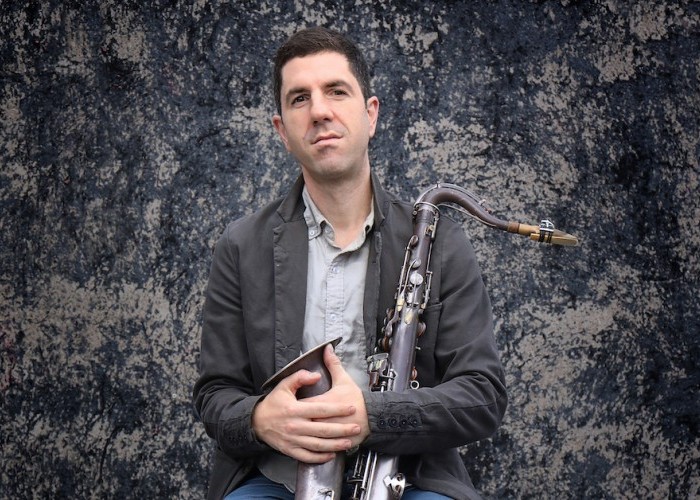Oct 28, 2025 10:47 AM
In Memoriam: Jack DeJohnette, 1942–2025
Jack DeJohnette, a bold and resourceful drummer and NEA Jazz Master who forged a unique vocabulary on the kit over his…

Dan Blake’s jazz life is much inspired by his activist efforts.
(Photo: Christopher Drukker)Saxophonist-composer Dan Blake has long been entrenched in the jazz world. But, more recently, he’s begun to engage deeply with several activist movements by way of his long-time study of Buddhism.
Specifically, Blake strives to live a life of compassionate action, a Buddhist teaching that emphasizes giving without the expectation of getting something in return. This idea motivates his social activism around food insecurity and climate change, and inspired his latest album, Da Fé (Sunnyside). The recording features pianist Carmen Staaf, bassist Dmitry Ishenko, drummer Jeff Williams and pianist Leo Genovese.
“I am trying to respond to the inspiration that I’ve received from the masters in jazz music,” Blake said. “There’s an urgency to this music that has always been so inspiring to me, and I have recently, in the last five years, started to connect this urgency more to the work of movement organizers who are working urgently to address very serious existential problems.”
Blake’s journey to discovery began nine years ago, when an interest in Buddhist meditation that developed during his college years led him to a volunteer opportunity.
“[Meditation] had very little to do with music [at first],” he said. “It was a separate sphere. But [in 2008], this new organization, Buddhist Global Relief, was formed, and a few years later, some members of the meditation group I was going to were like, ‘Does anyone want to volunteer?’ I said, ‘Well, I’m in this band — I’ll ask if the band wants to come play a benefit concert for Buddhist Global Relief.’ And, we did.”
Since that performance, Blake has organized nine benefit shows called “Concert to Feed the Hungry” for Buddhist Global Relief. He has also become a board member of the organization.
In addition, Blake has become involved with organizations like Extinction Rebellion, which aims to encourage government action against climate change through the use of nonviolent civil disobedience.
As Blake’s life starts to revolve more around giving back, he’s found it gives his creative life “sustenance” and helped him see intersections between jazz and his social action.
“According to the World Food Program, there are 700 million people around the world who are in a situation of either acute or constant hunger or food insecurity, and that is a humanitarian emergency that’s incredibly urgent,” Blake said. “That kind of urgency relates to the urgency that I hear in improvised music that comes from the African American tradition, which itself is an outgrowth of humanitarian crisis.”
Da Fé is a direct result of Blake’s recognition of the parallels between these worlds, each born from a need for urgent innovation. Da Fé’s post-bop compositions are emotionally intense and highly exploratory, exemplifying Blake’s grasp of improvisational expression and jazz collaboration, as well as his introspection around world crises and the roles of the collective and the individual in affecting change. In fact, Blake asserts that this album was, in some ways, a tool for self-interrogation and discovery around world issues.
“I wanted to embrace exploring a musical landscape through layers and density — creating a hall-of-mirrors effect,” he said. “I think if you take [that] analogy, there is the [idea of] many selves, so I think this album is absolutely a self-exploration.”
Da Fé is equally inspired by the spiritual and activist leaders Blake has crossed paths with, who, he said, instill hope for a better future. In fact, the album’s Portuguese title translates to “of faith.”
Blake is careful not to conflate himself with the leaders he tributes on the album. Instead, he identifies as a member of these movements, and situates Da Fé as an invitation for listeners.
“I think it’s important to draw attention to both the extraordinary beauty of [jazz] music that points to an intense need to engage with the world, but also to point to this other piece [with Da Fé],” Blake said. “These social movements are trying to collectively change our politics, our way of relating to one another, our way of considering how we should be in society together. Putting this music out to the world then becomes: ‘Let’s dive into this together.’” DB

Jack DeJohnette boasted a musical resume that was as long as it was fearsome.
Oct 28, 2025 10:47 AM
Jack DeJohnette, a bold and resourceful drummer and NEA Jazz Master who forged a unique vocabulary on the kit over his…

D’Angelo achieved commercial and critical success experimenting with a fusion of jazz, funk, soul, R&B and hip-hop.
Oct 14, 2025 1:47 PM
D’Angelo, a Grammy-winning R&B and neo-soul singer, guitarist and pianist who exerted a profound influence on 21st…

Kandace Springs channeled Shirley Horn’s deliberate phrasing and sublime self-accompaniment during her set at this year’s Pittsburgh International Jazz Festival.
Sep 30, 2025 12:28 PM
Janis Burley, the Pittsburgh International Jazz Festival’s founder and artistic director, did not, as might be…

Jim McNeely’s singular body of work had a profound and lasting influence on many of today’s top jazz composers in the U.S. and in Europe.
Oct 7, 2025 3:40 PM
Pianist Jim McNeely, one of the most distinguished large ensemble jazz composers of his generation, died Sept. 26 at…

Drummond was cherished by generations of mainstream jazz listeners and bandleaders for his authoritative tonal presence, a defining quality of his style most apparent when he played his instrument unamplified.
Nov 4, 2025 11:39 AM
Ray Drummond, a first-call bassist who appeared on hundreds of albums as a sideman for some of the top names in jazz…